Comprehensive Analysis of UK Financial Markets and International Trade
VerifiedAdded on 2020/11/23
|12
|3412
|106
Report
AI Summary
This report provides a comprehensive analysis of the UK financial market, international trade, and the broader economy. It delves into key aspects such as debt and equity dynamics, the UK banking system, and the performance of stock markets, including the London Stock Exchange. The report examines the role of the Bank of England, monetary policies, and financial regulations. Furthermore, it explores the international economy, capital allocation, and the significance of commercial banks, bond markets, and foreign exchange markets. The report also evaluates emerging economies, specifically focusing on BRICS nations and the manufacturing landscape in China, including inflation, employment, and international trade. It addresses the challenges China faces due to industrialization, trade policies, and the influence of the WTO. The report concludes with a discussion of non-bank financial institutions like pension funds and insurance companies, providing a holistic view of the UK's financial landscape and its global connections.
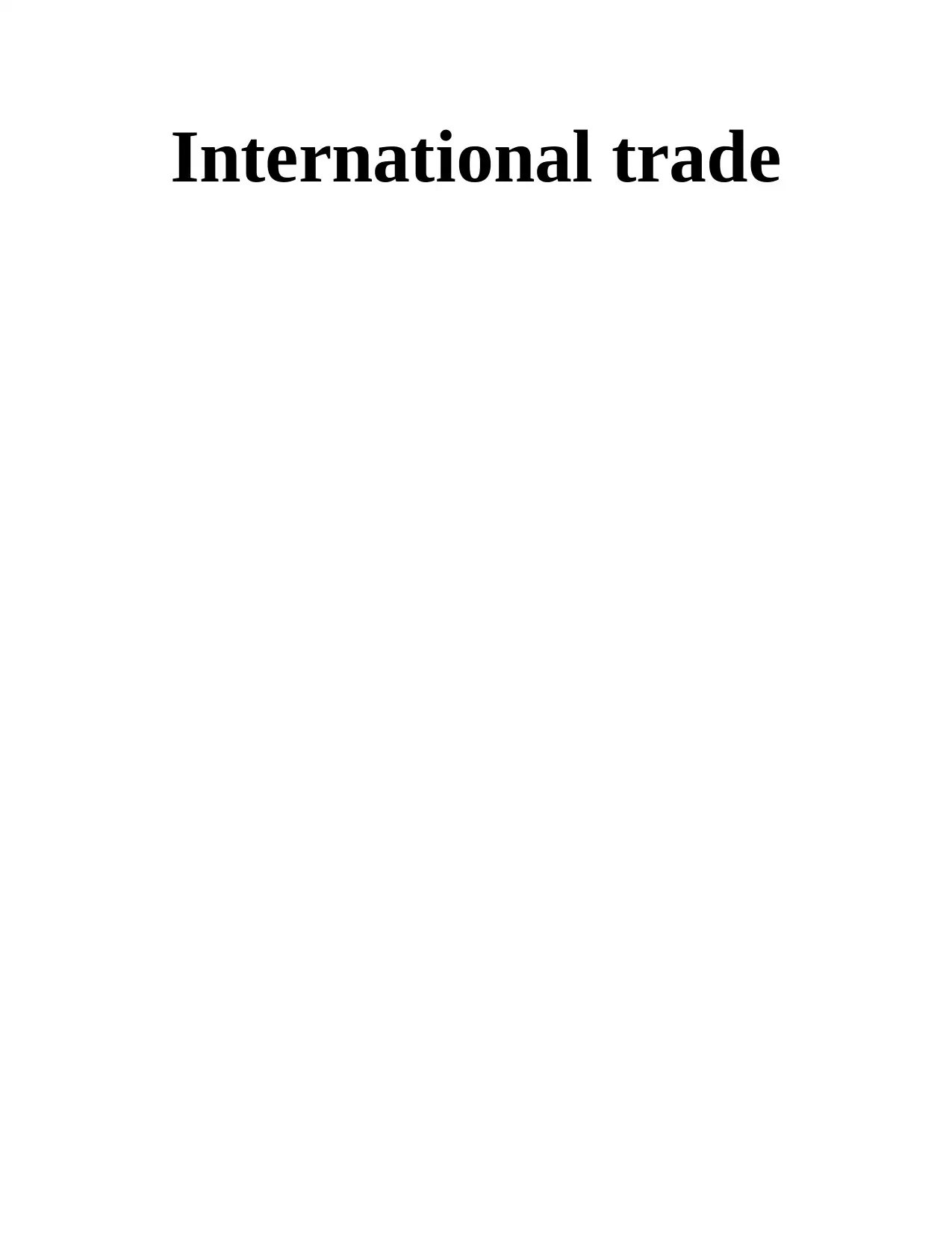
International trade
Paraphrase This Document
Need a fresh take? Get an instant paraphrase of this document with our AI Paraphraser
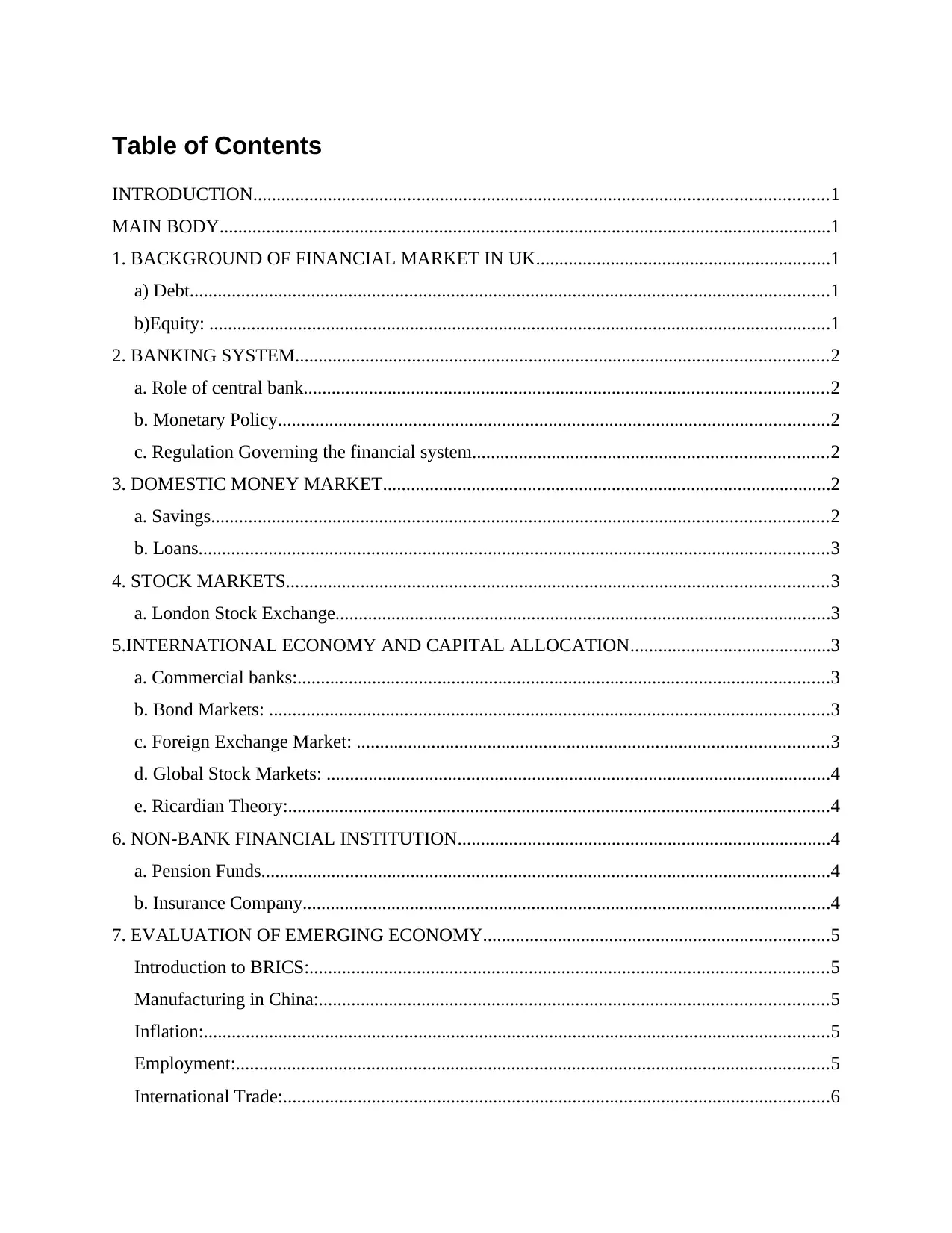
Table of Contents
INTRODUCTION...........................................................................................................................1
MAIN BODY...................................................................................................................................1
1. BACKGROUND OF FINANCIAL MARKET IN UK...............................................................1
a) Debt.........................................................................................................................................1
b)Equity: .....................................................................................................................................1
2. BANKING SYSTEM..................................................................................................................2
a. Role of central bank................................................................................................................2
b. Monetary Policy......................................................................................................................2
c. Regulation Governing the financial system............................................................................2
3. DOMESTIC MONEY MARKET................................................................................................2
a. Savings....................................................................................................................................2
b. Loans.......................................................................................................................................3
4. STOCK MARKETS....................................................................................................................3
a. London Stock Exchange..........................................................................................................3
5.INTERNATIONAL ECONOMY AND CAPITAL ALLOCATION...........................................3
a. Commercial banks:..................................................................................................................3
b. Bond Markets: ........................................................................................................................3
c. Foreign Exchange Market: .....................................................................................................3
d. Global Stock Markets: ............................................................................................................4
e. Ricardian Theory:....................................................................................................................4
6. NON-BANK FINANCIAL INSTITUTION................................................................................4
a. Pension Funds..........................................................................................................................4
b. Insurance Company.................................................................................................................4
7. EVALUATION OF EMERGING ECONOMY..........................................................................5
Introduction to BRICS:...............................................................................................................5
Manufacturing in China:.............................................................................................................5
Inflation:......................................................................................................................................5
Employment:...............................................................................................................................5
International Trade:.....................................................................................................................6
INTRODUCTION...........................................................................................................................1
MAIN BODY...................................................................................................................................1
1. BACKGROUND OF FINANCIAL MARKET IN UK...............................................................1
a) Debt.........................................................................................................................................1
b)Equity: .....................................................................................................................................1
2. BANKING SYSTEM..................................................................................................................2
a. Role of central bank................................................................................................................2
b. Monetary Policy......................................................................................................................2
c. Regulation Governing the financial system............................................................................2
3. DOMESTIC MONEY MARKET................................................................................................2
a. Savings....................................................................................................................................2
b. Loans.......................................................................................................................................3
4. STOCK MARKETS....................................................................................................................3
a. London Stock Exchange..........................................................................................................3
5.INTERNATIONAL ECONOMY AND CAPITAL ALLOCATION...........................................3
a. Commercial banks:..................................................................................................................3
b. Bond Markets: ........................................................................................................................3
c. Foreign Exchange Market: .....................................................................................................3
d. Global Stock Markets: ............................................................................................................4
e. Ricardian Theory:....................................................................................................................4
6. NON-BANK FINANCIAL INSTITUTION................................................................................4
a. Pension Funds..........................................................................................................................4
b. Insurance Company.................................................................................................................4
7. EVALUATION OF EMERGING ECONOMY..........................................................................5
Introduction to BRICS:...............................................................................................................5
Manufacturing in China:.............................................................................................................5
Inflation:......................................................................................................................................5
Employment:...............................................................................................................................5
International Trade:.....................................................................................................................6
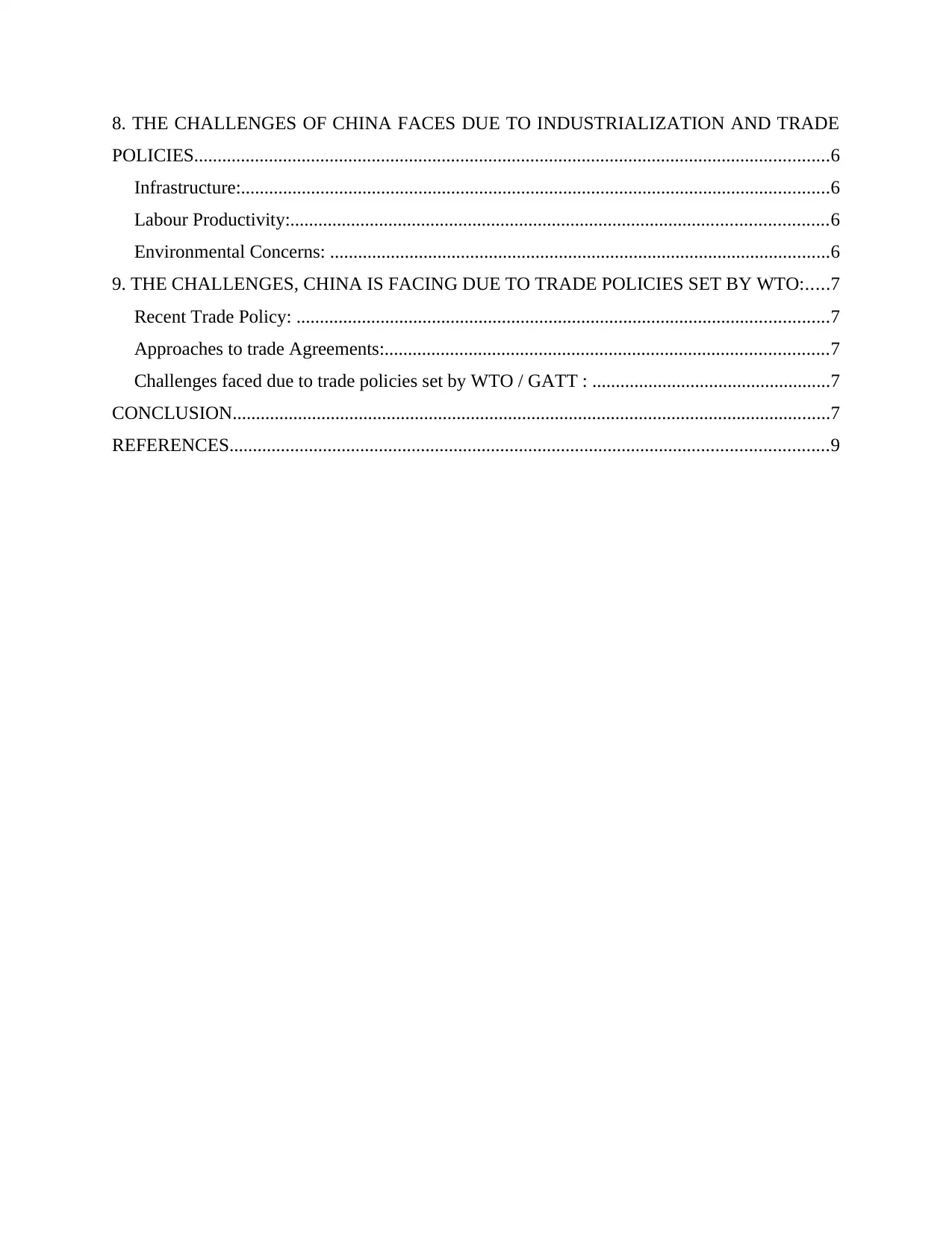
8. THE CHALLENGES OF CHINA FACES DUE TO INDUSTRIALIZATION AND TRADE
POLICIES........................................................................................................................................6
Infrastructure:..............................................................................................................................6
Labour Productivity:...................................................................................................................6
Environmental Concerns: ...........................................................................................................6
9. THE CHALLENGES, CHINA IS FACING DUE TO TRADE POLICIES SET BY WTO:.....7
Recent Trade Policy: ..................................................................................................................7
Approaches to trade Agreements:...............................................................................................7
Challenges faced due to trade policies set by WTO / GATT : ...................................................7
CONCLUSION................................................................................................................................7
REFERENCES................................................................................................................................9
POLICIES........................................................................................................................................6
Infrastructure:..............................................................................................................................6
Labour Productivity:...................................................................................................................6
Environmental Concerns: ...........................................................................................................6
9. THE CHALLENGES, CHINA IS FACING DUE TO TRADE POLICIES SET BY WTO:.....7
Recent Trade Policy: ..................................................................................................................7
Approaches to trade Agreements:...............................................................................................7
Challenges faced due to trade policies set by WTO / GATT : ...................................................7
CONCLUSION................................................................................................................................7
REFERENCES................................................................................................................................9
⊘ This is a preview!⊘
Do you want full access?
Subscribe today to unlock all pages.

Trusted by 1+ million students worldwide
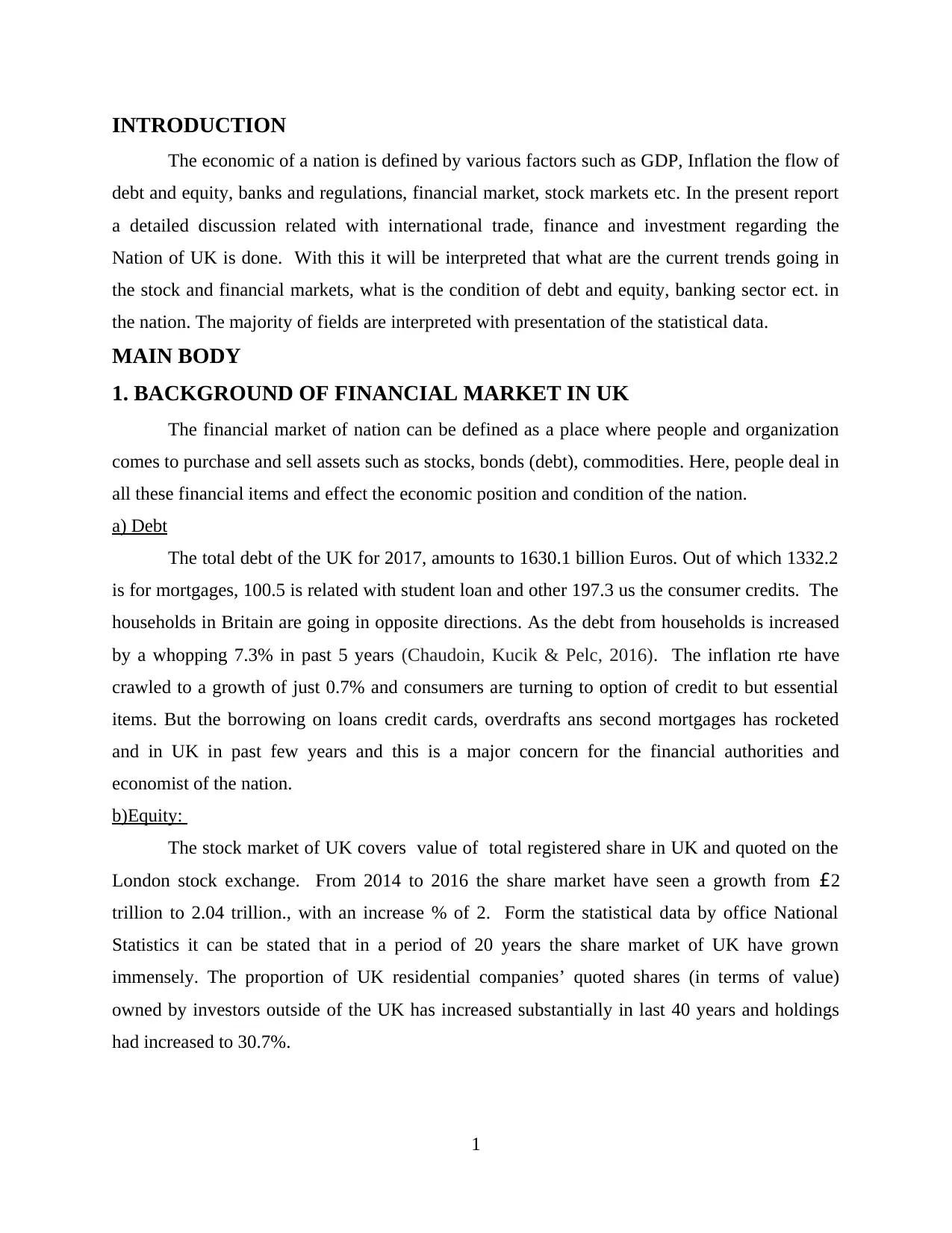
INTRODUCTION
The economic of a nation is defined by various factors such as GDP, Inflation the flow of
debt and equity, banks and regulations, financial market, stock markets etc. In the present report
a detailed discussion related with international trade, finance and investment regarding the
Nation of UK is done. With this it will be interpreted that what are the current trends going in
the stock and financial markets, what is the condition of debt and equity, banking sector ect. in
the nation. The majority of fields are interpreted with presentation of the statistical data.
MAIN BODY
1. BACKGROUND OF FINANCIAL MARKET IN UK
The financial market of nation can be defined as a place where people and organization
comes to purchase and sell assets such as stocks, bonds (debt), commodities. Here, people deal in
all these financial items and effect the economic position and condition of the nation.
a) Debt
The total debt of the UK for 2017, amounts to 1630.1 billion Euros. Out of which 1332.2
is for mortgages, 100.5 is related with student loan and other 197.3 us the consumer credits. The
households in Britain are going in opposite directions. As the debt from households is increased
by a whopping 7.3% in past 5 years (Chaudoin, Kucik & Pelc, 2016). The inflation rte have
crawled to a growth of just 0.7% and consumers are turning to option of credit to but essential
items. But the borrowing on loans credit cards, overdrafts ans second mortgages has rocketed
and in UK in past few years and this is a major concern for the financial authorities and
economist of the nation.
b)Equity:
The stock market of UK covers value of total registered share in UK and quoted on the
London stock exchange. From 2014 to 2016 the share market have seen a growth from £2
trillion to 2.04 trillion., with an increase % of 2. Form the statistical data by office National
Statistics it can be stated that in a period of 20 years the share market of UK have grown
immensely. The proportion of UK residential companies’ quoted shares (in terms of value)
owned by investors outside of the UK has increased substantially in last 40 years and holdings
had increased to 30.7%.
1
The economic of a nation is defined by various factors such as GDP, Inflation the flow of
debt and equity, banks and regulations, financial market, stock markets etc. In the present report
a detailed discussion related with international trade, finance and investment regarding the
Nation of UK is done. With this it will be interpreted that what are the current trends going in
the stock and financial markets, what is the condition of debt and equity, banking sector ect. in
the nation. The majority of fields are interpreted with presentation of the statistical data.
MAIN BODY
1. BACKGROUND OF FINANCIAL MARKET IN UK
The financial market of nation can be defined as a place where people and organization
comes to purchase and sell assets such as stocks, bonds (debt), commodities. Here, people deal in
all these financial items and effect the economic position and condition of the nation.
a) Debt
The total debt of the UK for 2017, amounts to 1630.1 billion Euros. Out of which 1332.2
is for mortgages, 100.5 is related with student loan and other 197.3 us the consumer credits. The
households in Britain are going in opposite directions. As the debt from households is increased
by a whopping 7.3% in past 5 years (Chaudoin, Kucik & Pelc, 2016). The inflation rte have
crawled to a growth of just 0.7% and consumers are turning to option of credit to but essential
items. But the borrowing on loans credit cards, overdrafts ans second mortgages has rocketed
and in UK in past few years and this is a major concern for the financial authorities and
economist of the nation.
b)Equity:
The stock market of UK covers value of total registered share in UK and quoted on the
London stock exchange. From 2014 to 2016 the share market have seen a growth from £2
trillion to 2.04 trillion., with an increase % of 2. Form the statistical data by office National
Statistics it can be stated that in a period of 20 years the share market of UK have grown
immensely. The proportion of UK residential companies’ quoted shares (in terms of value)
owned by investors outside of the UK has increased substantially in last 40 years and holdings
had increased to 30.7%.
1
Paraphrase This Document
Need a fresh take? Get an instant paraphrase of this document with our AI Paraphraser

2. BANKING SYSTEM
a. Role of central bank
Central bank of UK is Bank of England which aim at maintaining monetary stability in
financial system of UK. The bank is also known as last resort lender and has custodian of goals
reserves of United Kingdom. The main function of BOE managing sustainability in economic
growth by controlling liquidity. It oversees monetary policy and is responsible from issuing
currency like any another central bank of countries. BOE work in corporation with hm treasury
central banks of other countries and financial service authorities.
b. Monetary Policy
Monetary policy of UK aim at maintaining low inflation and economic growth by
working on various factors like interest rates, analysing demand graph, impact of power on
supply, etc. In accordance with monetary policy current bank rate of UK is 0.75 % while current
inflation rate is 2.4 % but the target of Bank of England is to make it 2.0 % (Monetary policy,
2018). Meeting of monetary policy committee comprise pre session in which the latest data of
economic conditions analysed. Further, in first meeting analysed data is discussed while in
second meeting arguments occurs on the basis of which policy action is taken. The final meeting
of monetary policy is based on recommendation of governor on managing changes n policy plan
and finally the announcement is made on Thursday of week at 12 noon.
c. Regulation Governing the financial system
Financial regulations is kind of supervision which are subjected to financial institution for
managing sustainability in working practices. It is focused on setting certain restrictions,
guidelines and requirements with the aim of maintaining integrity in financial services. Financial
conduct authority control financial companies who enable finance to consumers. It is important
for the firm to main dignity and integrity in finance services for promoting growth and stability
of financial markets. On the other hand there is financial reporting council which enables set of
framework for managing financial accounts of business and services provided to consumers.
3. DOMESTIC MONEY MARKET
a. Savings
Saving is beneficial term for domestic market of UK s it is in favour of consumer as well
as financial service institutions. UK interest rate has been hiked and is 0.75 % which promotes
2
a. Role of central bank
Central bank of UK is Bank of England which aim at maintaining monetary stability in
financial system of UK. The bank is also known as last resort lender and has custodian of goals
reserves of United Kingdom. The main function of BOE managing sustainability in economic
growth by controlling liquidity. It oversees monetary policy and is responsible from issuing
currency like any another central bank of countries. BOE work in corporation with hm treasury
central banks of other countries and financial service authorities.
b. Monetary Policy
Monetary policy of UK aim at maintaining low inflation and economic growth by
working on various factors like interest rates, analysing demand graph, impact of power on
supply, etc. In accordance with monetary policy current bank rate of UK is 0.75 % while current
inflation rate is 2.4 % but the target of Bank of England is to make it 2.0 % (Monetary policy,
2018). Meeting of monetary policy committee comprise pre session in which the latest data of
economic conditions analysed. Further, in first meeting analysed data is discussed while in
second meeting arguments occurs on the basis of which policy action is taken. The final meeting
of monetary policy is based on recommendation of governor on managing changes n policy plan
and finally the announcement is made on Thursday of week at 12 noon.
c. Regulation Governing the financial system
Financial regulations is kind of supervision which are subjected to financial institution for
managing sustainability in working practices. It is focused on setting certain restrictions,
guidelines and requirements with the aim of maintaining integrity in financial services. Financial
conduct authority control financial companies who enable finance to consumers. It is important
for the firm to main dignity and integrity in finance services for promoting growth and stability
of financial markets. On the other hand there is financial reporting council which enables set of
framework for managing financial accounts of business and services provided to consumers.
3. DOMESTIC MONEY MARKET
a. Savings
Saving is beneficial term for domestic market of UK s it is in favour of consumer as well
as financial service institutions. UK interest rate has been hiked and is 0.75 % which promotes
2
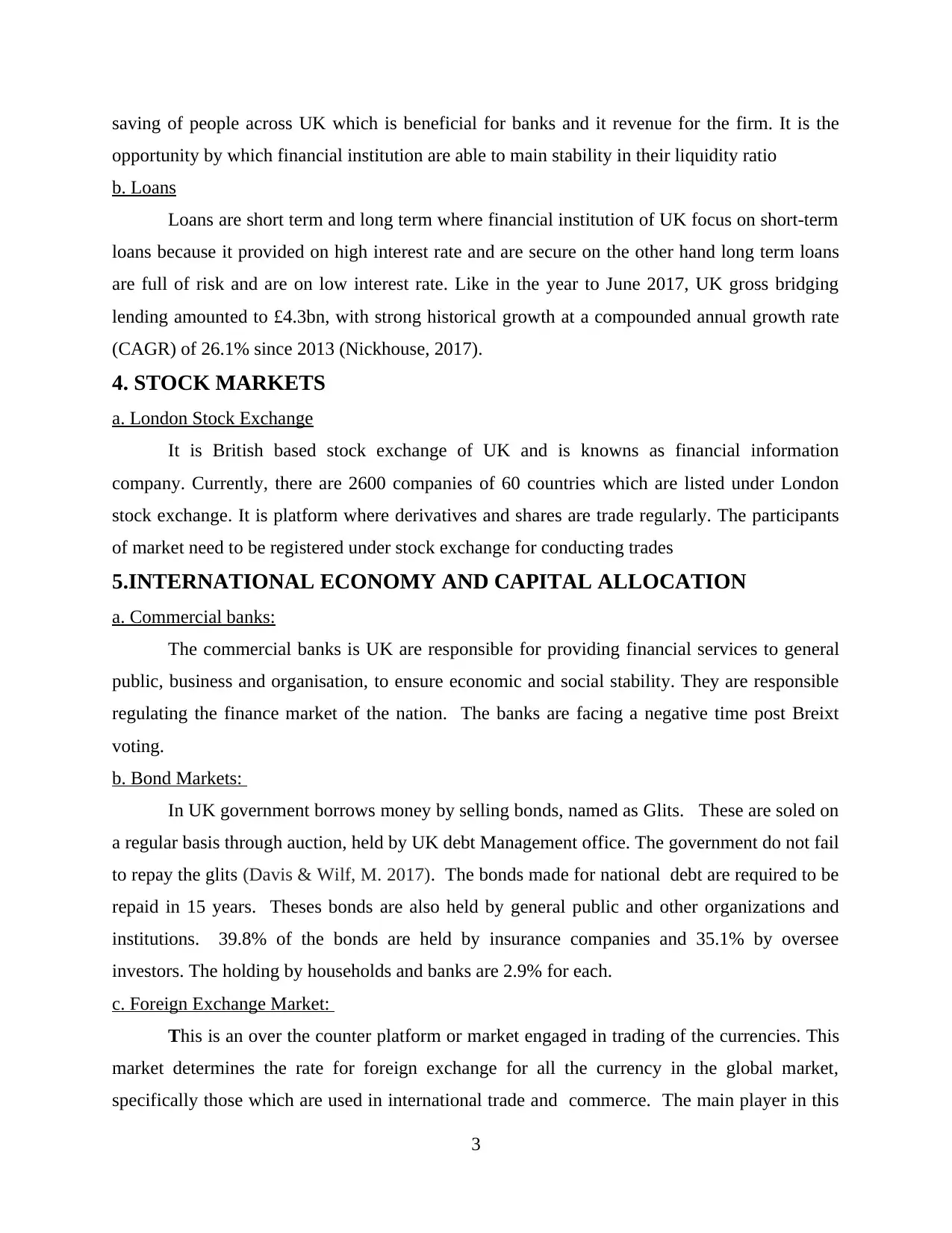
saving of people across UK which is beneficial for banks and it revenue for the firm. It is the
opportunity by which financial institution are able to main stability in their liquidity ratio
b. Loans
Loans are short term and long term where financial institution of UK focus on short-term
loans because it provided on high interest rate and are secure on the other hand long term loans
are full of risk and are on low interest rate. Like in the year to June 2017, UK gross bridging
lending amounted to £4.3bn, with strong historical growth at a compounded annual growth rate
(CAGR) of 26.1% since 2013 (Nickhouse, 2017).
4. STOCK MARKETS
a. London Stock Exchange
It is British based stock exchange of UK and is knowns as financial information
company. Currently, there are 2600 companies of 60 countries which are listed under London
stock exchange. It is platform where derivatives and shares are trade regularly. The participants
of market need to be registered under stock exchange for conducting trades
5.INTERNATIONAL ECONOMY AND CAPITAL ALLOCATION
a. Commercial banks:
The commercial banks is UK are responsible for providing financial services to general
public, business and organisation, to ensure economic and social stability. They are responsible
regulating the finance market of the nation. The banks are facing a negative time post Breixt
voting.
b. Bond Markets:
In UK government borrows money by selling bonds, named as Glits. These are soled on
a regular basis through auction, held by UK debt Management office. The government do not fail
to repay the glits (Davis & Wilf, M. 2017). The bonds made for national debt are required to be
repaid in 15 years. Theses bonds are also held by general public and other organizations and
institutions. 39.8% of the bonds are held by insurance companies and 35.1% by oversee
investors. The holding by households and banks are 2.9% for each.
c. Foreign Exchange Market:
This is an over the counter platform or market engaged in trading of the currencies. This
market determines the rate for foreign exchange for all the currency in the global market,
specifically those which are used in international trade and commerce. The main player in this
3
opportunity by which financial institution are able to main stability in their liquidity ratio
b. Loans
Loans are short term and long term where financial institution of UK focus on short-term
loans because it provided on high interest rate and are secure on the other hand long term loans
are full of risk and are on low interest rate. Like in the year to June 2017, UK gross bridging
lending amounted to £4.3bn, with strong historical growth at a compounded annual growth rate
(CAGR) of 26.1% since 2013 (Nickhouse, 2017).
4. STOCK MARKETS
a. London Stock Exchange
It is British based stock exchange of UK and is knowns as financial information
company. Currently, there are 2600 companies of 60 countries which are listed under London
stock exchange. It is platform where derivatives and shares are trade regularly. The participants
of market need to be registered under stock exchange for conducting trades
5.INTERNATIONAL ECONOMY AND CAPITAL ALLOCATION
a. Commercial banks:
The commercial banks is UK are responsible for providing financial services to general
public, business and organisation, to ensure economic and social stability. They are responsible
regulating the finance market of the nation. The banks are facing a negative time post Breixt
voting.
b. Bond Markets:
In UK government borrows money by selling bonds, named as Glits. These are soled on
a regular basis through auction, held by UK debt Management office. The government do not fail
to repay the glits (Davis & Wilf, M. 2017). The bonds made for national debt are required to be
repaid in 15 years. Theses bonds are also held by general public and other organizations and
institutions. 39.8% of the bonds are held by insurance companies and 35.1% by oversee
investors. The holding by households and banks are 2.9% for each.
c. Foreign Exchange Market:
This is an over the counter platform or market engaged in trading of the currencies. This
market determines the rate for foreign exchange for all the currency in the global market,
specifically those which are used in international trade and commerce. The main player in this
3
⊘ This is a preview!⊘
Do you want full access?
Subscribe today to unlock all pages.

Trusted by 1+ million students worldwide
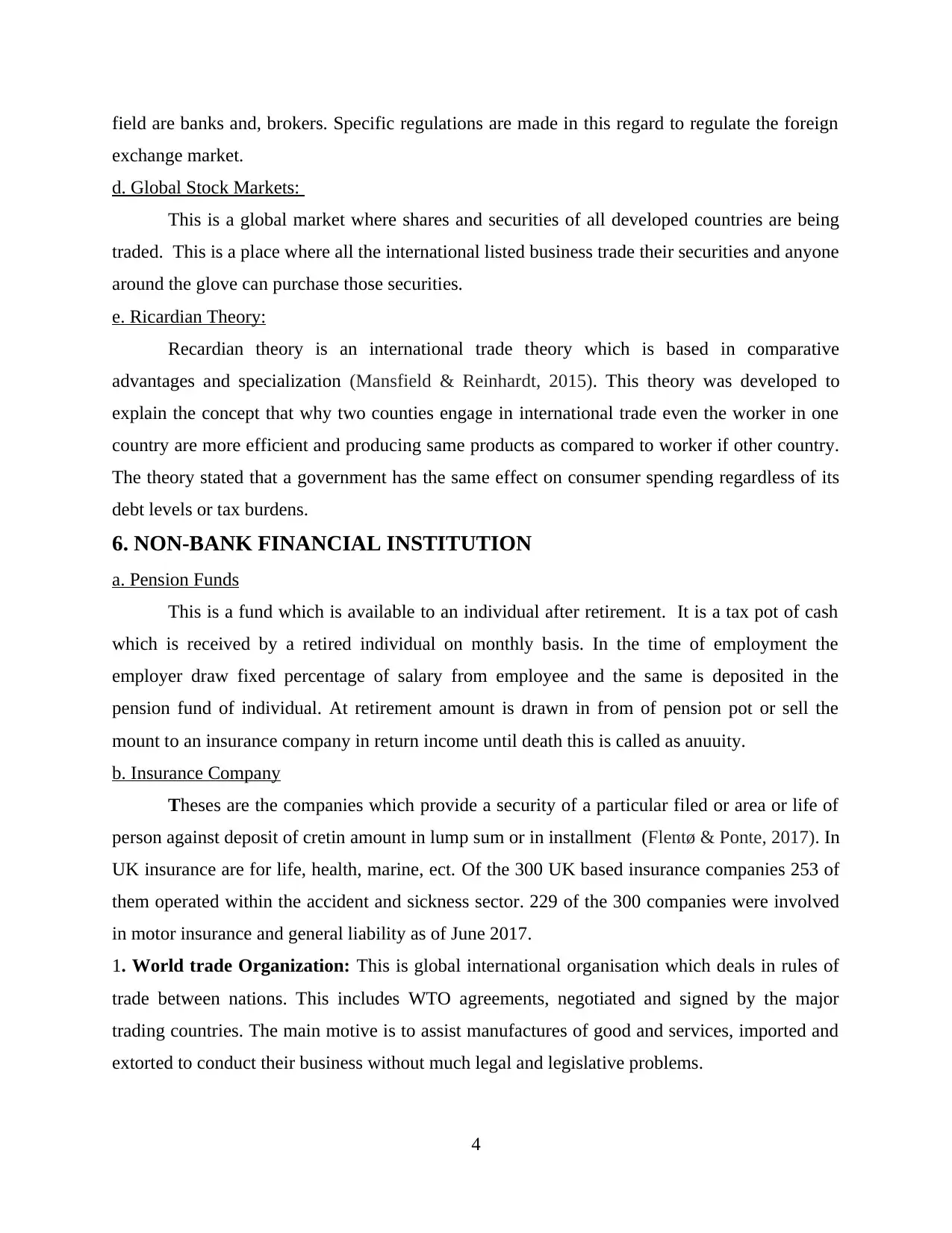
field are banks and, brokers. Specific regulations are made in this regard to regulate the foreign
exchange market.
d. Global Stock Markets:
This is a global market where shares and securities of all developed countries are being
traded. This is a place where all the international listed business trade their securities and anyone
around the glove can purchase those securities.
e. Ricardian Theory:
Recardian theory is an international trade theory which is based in comparative
advantages and specialization (Mansfield & Reinhardt, 2015). This theory was developed to
explain the concept that why two counties engage in international trade even the worker in one
country are more efficient and producing same products as compared to worker if other country.
The theory stated that a government has the same effect on consumer spending regardless of its
debt levels or tax burdens.
6. NON-BANK FINANCIAL INSTITUTION
a. Pension Funds
This is a fund which is available to an individual after retirement. It is a tax pot of cash
which is received by a retired individual on monthly basis. In the time of employment the
employer draw fixed percentage of salary from employee and the same is deposited in the
pension fund of individual. At retirement amount is drawn in from of pension pot or sell the
mount to an insurance company in return income until death this is called as anuuity.
b. Insurance Company
Theses are the companies which provide a security of a particular filed or area or life of
person against deposit of cretin amount in lump sum or in installment (Flentø & Ponte, 2017). In
UK insurance are for life, health, marine, ect. Of the 300 UK based insurance companies 253 of
them operated within the accident and sickness sector. 229 of the 300 companies were involved
in motor insurance and general liability as of June 2017.
1. World trade Organization: This is global international organisation which deals in rules of
trade between nations. This includes WTO agreements, negotiated and signed by the major
trading countries. The main motive is to assist manufactures of good and services, imported and
extorted to conduct their business without much legal and legislative problems.
4
exchange market.
d. Global Stock Markets:
This is a global market where shares and securities of all developed countries are being
traded. This is a place where all the international listed business trade their securities and anyone
around the glove can purchase those securities.
e. Ricardian Theory:
Recardian theory is an international trade theory which is based in comparative
advantages and specialization (Mansfield & Reinhardt, 2015). This theory was developed to
explain the concept that why two counties engage in international trade even the worker in one
country are more efficient and producing same products as compared to worker if other country.
The theory stated that a government has the same effect on consumer spending regardless of its
debt levels or tax burdens.
6. NON-BANK FINANCIAL INSTITUTION
a. Pension Funds
This is a fund which is available to an individual after retirement. It is a tax pot of cash
which is received by a retired individual on monthly basis. In the time of employment the
employer draw fixed percentage of salary from employee and the same is deposited in the
pension fund of individual. At retirement amount is drawn in from of pension pot or sell the
mount to an insurance company in return income until death this is called as anuuity.
b. Insurance Company
Theses are the companies which provide a security of a particular filed or area or life of
person against deposit of cretin amount in lump sum or in installment (Flentø & Ponte, 2017). In
UK insurance are for life, health, marine, ect. Of the 300 UK based insurance companies 253 of
them operated within the accident and sickness sector. 229 of the 300 companies were involved
in motor insurance and general liability as of June 2017.
1. World trade Organization: This is global international organisation which deals in rules of
trade between nations. This includes WTO agreements, negotiated and signed by the major
trading countries. The main motive is to assist manufactures of good and services, imported and
extorted to conduct their business without much legal and legislative problems.
4
Paraphrase This Document
Need a fresh take? Get an instant paraphrase of this document with our AI Paraphraser
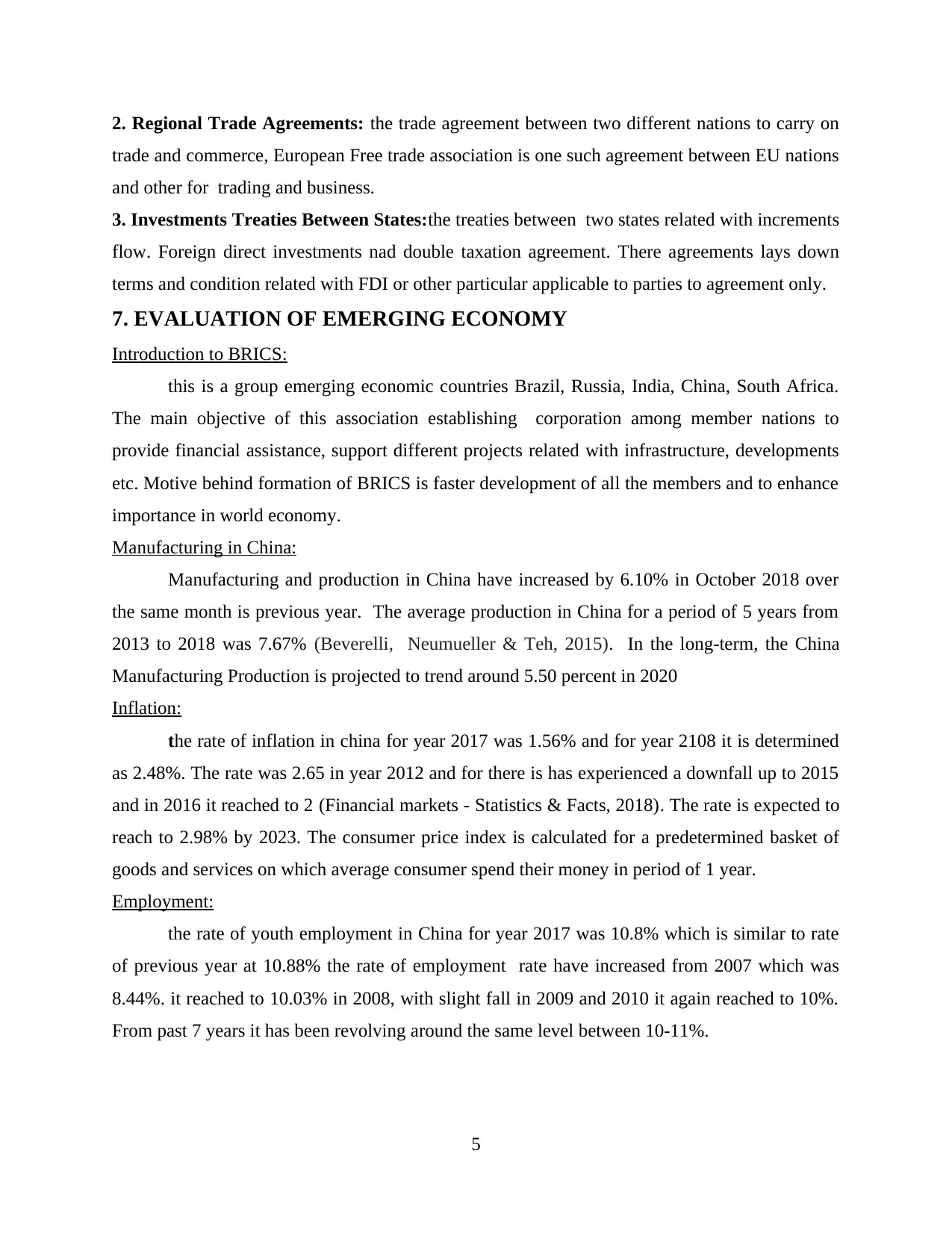
2. Regional Trade Agreements: the trade agreement between two different nations to carry on
trade and commerce, European Free trade association is one such agreement between EU nations
and other for trading and business.
3. Investments Treaties Between States:the treaties between two states related with increments
flow. Foreign direct investments nad double taxation agreement. There agreements lays down
terms and condition related with FDI or other particular applicable to parties to agreement only.
7. EVALUATION OF EMERGING ECONOMY
Introduction to BRICS:
this is a group emerging economic countries Brazil, Russia, India, China, South Africa.
The main objective of this association establishing corporation among member nations to
provide financial assistance, support different projects related with infrastructure, developments
etc. Motive behind formation of BRICS is faster development of all the members and to enhance
importance in world economy.
Manufacturing in China:
Manufacturing and production in China have increased by 6.10% in October 2018 over
the same month is previous year. The average production in China for a period of 5 years from
2013 to 2018 was 7.67% (Beverelli, Neumueller & Teh, 2015). In the long-term, the China
Manufacturing Production is projected to trend around 5.50 percent in 2020
Inflation:
the rate of inflation in china for year 2017 was 1.56% and for year 2108 it is determined
as 2.48%. The rate was 2.65 in year 2012 and for there is has experienced a downfall up to 2015
and in 2016 it reached to 2 (Financial markets - Statistics & Facts, 2018). The rate is expected to
reach to 2.98% by 2023. The consumer price index is calculated for a predetermined basket of
goods and services on which average consumer spend their money in period of 1 year.
Employment:
the rate of youth employment in China for year 2017 was 10.8% which is similar to rate
of previous year at 10.88% the rate of employment rate have increased from 2007 which was
8.44%. it reached to 10.03% in 2008, with slight fall in 2009 and 2010 it again reached to 10%.
From past 7 years it has been revolving around the same level between 10-11%.
5
trade and commerce, European Free trade association is one such agreement between EU nations
and other for trading and business.
3. Investments Treaties Between States:the treaties between two states related with increments
flow. Foreign direct investments nad double taxation agreement. There agreements lays down
terms and condition related with FDI or other particular applicable to parties to agreement only.
7. EVALUATION OF EMERGING ECONOMY
Introduction to BRICS:
this is a group emerging economic countries Brazil, Russia, India, China, South Africa.
The main objective of this association establishing corporation among member nations to
provide financial assistance, support different projects related with infrastructure, developments
etc. Motive behind formation of BRICS is faster development of all the members and to enhance
importance in world economy.
Manufacturing in China:
Manufacturing and production in China have increased by 6.10% in October 2018 over
the same month is previous year. The average production in China for a period of 5 years from
2013 to 2018 was 7.67% (Beverelli, Neumueller & Teh, 2015). In the long-term, the China
Manufacturing Production is projected to trend around 5.50 percent in 2020
Inflation:
the rate of inflation in china for year 2017 was 1.56% and for year 2108 it is determined
as 2.48%. The rate was 2.65 in year 2012 and for there is has experienced a downfall up to 2015
and in 2016 it reached to 2 (Financial markets - Statistics & Facts, 2018). The rate is expected to
reach to 2.98% by 2023. The consumer price index is calculated for a predetermined basket of
goods and services on which average consumer spend their money in period of 1 year.
Employment:
the rate of youth employment in China for year 2017 was 10.8% which is similar to rate
of previous year at 10.88% the rate of employment rate have increased from 2007 which was
8.44%. it reached to 10.03% in 2008, with slight fall in 2009 and 2010 it again reached to 10%.
From past 7 years it has been revolving around the same level between 10-11%.
5
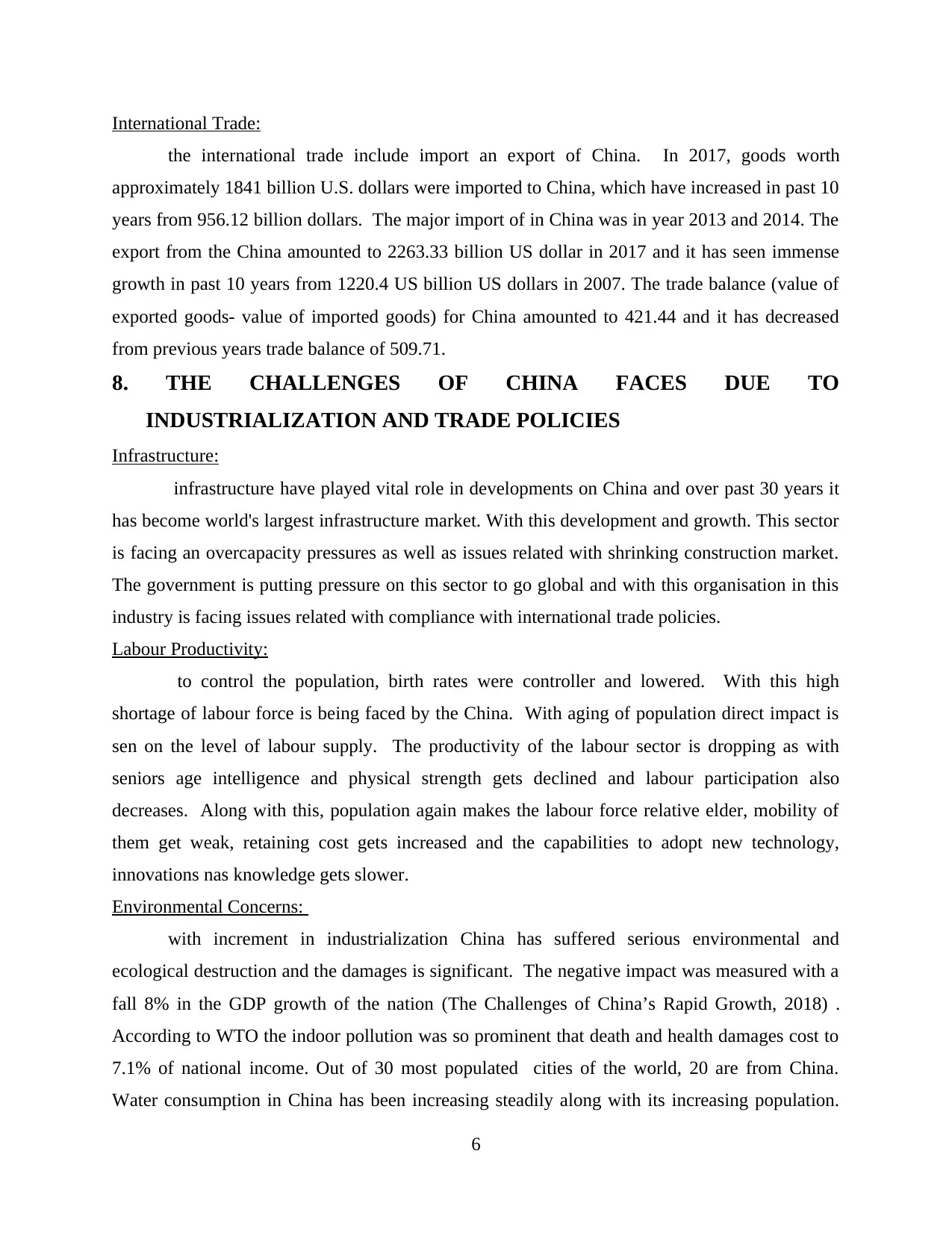
International Trade:
the international trade include import an export of China. In 2017, goods worth
approximately 1841 billion U.S. dollars were imported to China, which have increased in past 10
years from 956.12 billion dollars. The major import of in China was in year 2013 and 2014. The
export from the China amounted to 2263.33 billion US dollar in 2017 and it has seen immense
growth in past 10 years from 1220.4 US billion US dollars in 2007. The trade balance (value of
exported goods- value of imported goods) for China amounted to 421.44 and it has decreased
from previous years trade balance of 509.71.
8. THE CHALLENGES OF CHINA FACES DUE TO
INDUSTRIALIZATION AND TRADE POLICIES
Infrastructure:
infrastructure have played vital role in developments on China and over past 30 years it
has become world's largest infrastructure market. With this development and growth. This sector
is facing an overcapacity pressures as well as issues related with shrinking construction market.
The government is putting pressure on this sector to go global and with this organisation in this
industry is facing issues related with compliance with international trade policies.
Labour Productivity:
to control the population, birth rates were controller and lowered. With this high
shortage of labour force is being faced by the China. With aging of population direct impact is
sen on the level of labour supply. The productivity of the labour sector is dropping as with
seniors age intelligence and physical strength gets declined and labour participation also
decreases. Along with this, population again makes the labour force relative elder, mobility of
them get weak, retaining cost gets increased and the capabilities to adopt new technology,
innovations nas knowledge gets slower.
Environmental Concerns:
with increment in industrialization China has suffered serious environmental and
ecological destruction and the damages is significant. The negative impact was measured with a
fall 8% in the GDP growth of the nation (The Challenges of China’s Rapid Growth, 2018) .
According to WTO the indoor pollution was so prominent that death and health damages cost to
7.1% of national income. Out of 30 most populated cities of the world, 20 are from China.
Water consumption in China has been increasing steadily along with its increasing population.
6
the international trade include import an export of China. In 2017, goods worth
approximately 1841 billion U.S. dollars were imported to China, which have increased in past 10
years from 956.12 billion dollars. The major import of in China was in year 2013 and 2014. The
export from the China amounted to 2263.33 billion US dollar in 2017 and it has seen immense
growth in past 10 years from 1220.4 US billion US dollars in 2007. The trade balance (value of
exported goods- value of imported goods) for China amounted to 421.44 and it has decreased
from previous years trade balance of 509.71.
8. THE CHALLENGES OF CHINA FACES DUE TO
INDUSTRIALIZATION AND TRADE POLICIES
Infrastructure:
infrastructure have played vital role in developments on China and over past 30 years it
has become world's largest infrastructure market. With this development and growth. This sector
is facing an overcapacity pressures as well as issues related with shrinking construction market.
The government is putting pressure on this sector to go global and with this organisation in this
industry is facing issues related with compliance with international trade policies.
Labour Productivity:
to control the population, birth rates were controller and lowered. With this high
shortage of labour force is being faced by the China. With aging of population direct impact is
sen on the level of labour supply. The productivity of the labour sector is dropping as with
seniors age intelligence and physical strength gets declined and labour participation also
decreases. Along with this, population again makes the labour force relative elder, mobility of
them get weak, retaining cost gets increased and the capabilities to adopt new technology,
innovations nas knowledge gets slower.
Environmental Concerns:
with increment in industrialization China has suffered serious environmental and
ecological destruction and the damages is significant. The negative impact was measured with a
fall 8% in the GDP growth of the nation (The Challenges of China’s Rapid Growth, 2018) .
According to WTO the indoor pollution was so prominent that death and health damages cost to
7.1% of national income. Out of 30 most populated cities of the world, 20 are from China.
Water consumption in China has been increasing steadily along with its increasing population.
6
⊘ This is a preview!⊘
Do you want full access?
Subscribe today to unlock all pages.

Trusted by 1+ million students worldwide
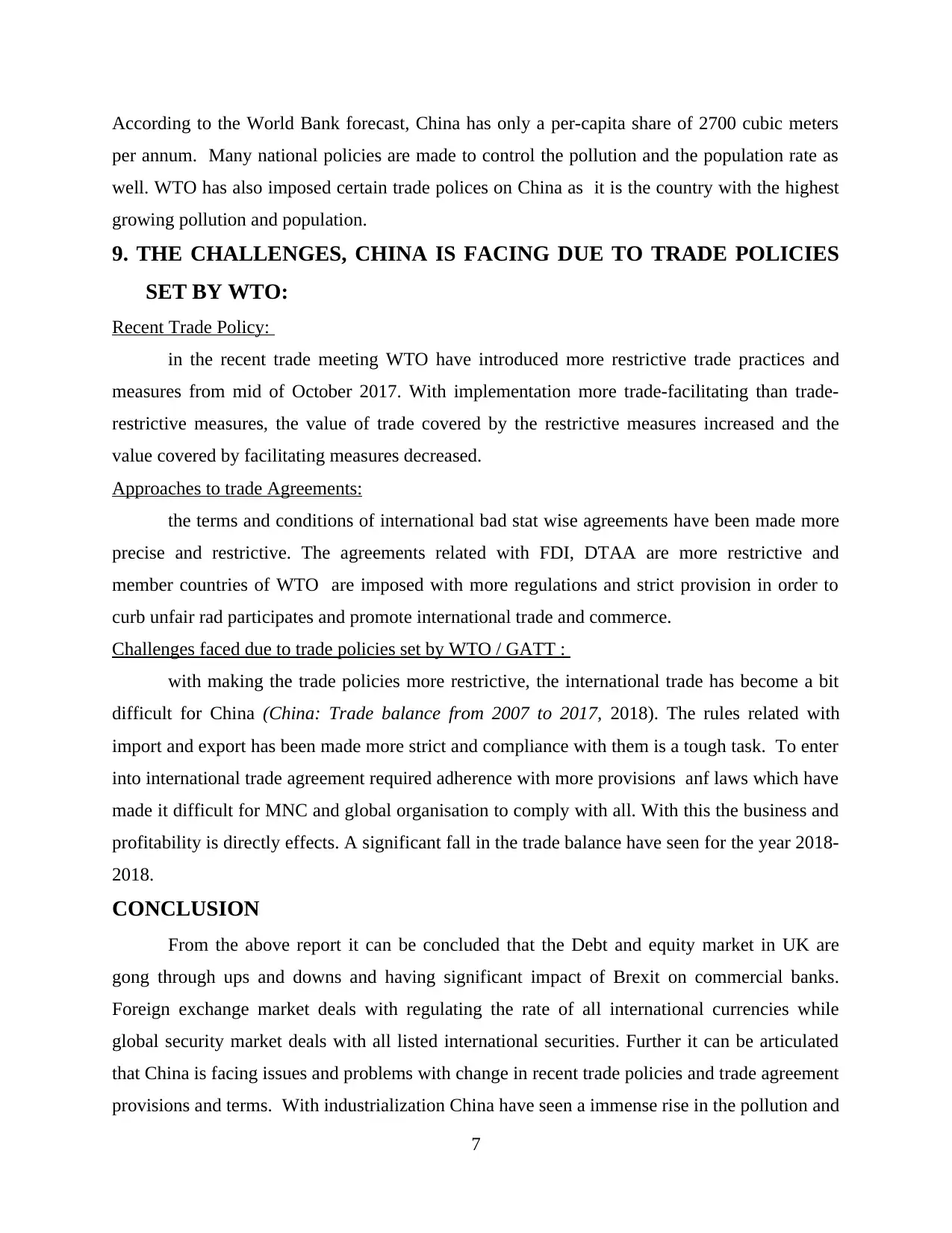
According to the World Bank forecast, China has only a per-capita share of 2700 cubic meters
per annum. Many national policies are made to control the pollution and the population rate as
well. WTO has also imposed certain trade polices on China as it is the country with the highest
growing pollution and population.
9. THE CHALLENGES, CHINA IS FACING DUE TO TRADE POLICIES
SET BY WTO:
Recent Trade Policy:
in the recent trade meeting WTO have introduced more restrictive trade practices and
measures from mid of October 2017. With implementation more trade-facilitating than trade-
restrictive measures, the value of trade covered by the restrictive measures increased and the
value covered by facilitating measures decreased.
Approaches to trade Agreements:
the terms and conditions of international bad stat wise agreements have been made more
precise and restrictive. The agreements related with FDI, DTAA are more restrictive and
member countries of WTO are imposed with more regulations and strict provision in order to
curb unfair rad participates and promote international trade and commerce.
Challenges faced due to trade policies set by WTO / GATT :
with making the trade policies more restrictive, the international trade has become a bit
difficult for China (China: Trade balance from 2007 to 2017, 2018). The rules related with
import and export has been made more strict and compliance with them is a tough task. To enter
into international trade agreement required adherence with more provisions anf laws which have
made it difficult for MNC and global organisation to comply with all. With this the business and
profitability is directly effects. A significant fall in the trade balance have seen for the year 2018-
2018.
CONCLUSION
From the above report it can be concluded that the Debt and equity market in UK are
gong through ups and downs and having significant impact of Brexit on commercial banks.
Foreign exchange market deals with regulating the rate of all international currencies while
global security market deals with all listed international securities. Further it can be articulated
that China is facing issues and problems with change in recent trade policies and trade agreement
provisions and terms. With industrialization China have seen a immense rise in the pollution and
7
per annum. Many national policies are made to control the pollution and the population rate as
well. WTO has also imposed certain trade polices on China as it is the country with the highest
growing pollution and population.
9. THE CHALLENGES, CHINA IS FACING DUE TO TRADE POLICIES
SET BY WTO:
Recent Trade Policy:
in the recent trade meeting WTO have introduced more restrictive trade practices and
measures from mid of October 2017. With implementation more trade-facilitating than trade-
restrictive measures, the value of trade covered by the restrictive measures increased and the
value covered by facilitating measures decreased.
Approaches to trade Agreements:
the terms and conditions of international bad stat wise agreements have been made more
precise and restrictive. The agreements related with FDI, DTAA are more restrictive and
member countries of WTO are imposed with more regulations and strict provision in order to
curb unfair rad participates and promote international trade and commerce.
Challenges faced due to trade policies set by WTO / GATT :
with making the trade policies more restrictive, the international trade has become a bit
difficult for China (China: Trade balance from 2007 to 2017, 2018). The rules related with
import and export has been made more strict and compliance with them is a tough task. To enter
into international trade agreement required adherence with more provisions anf laws which have
made it difficult for MNC and global organisation to comply with all. With this the business and
profitability is directly effects. A significant fall in the trade balance have seen for the year 2018-
2018.
CONCLUSION
From the above report it can be concluded that the Debt and equity market in UK are
gong through ups and downs and having significant impact of Brexit on commercial banks.
Foreign exchange market deals with regulating the rate of all international currencies while
global security market deals with all listed international securities. Further it can be articulated
that China is facing issues and problems with change in recent trade policies and trade agreement
provisions and terms. With industrialization China have seen a immense rise in the pollution and
7
Paraphrase This Document
Need a fresh take? Get an instant paraphrase of this document with our AI Paraphraser
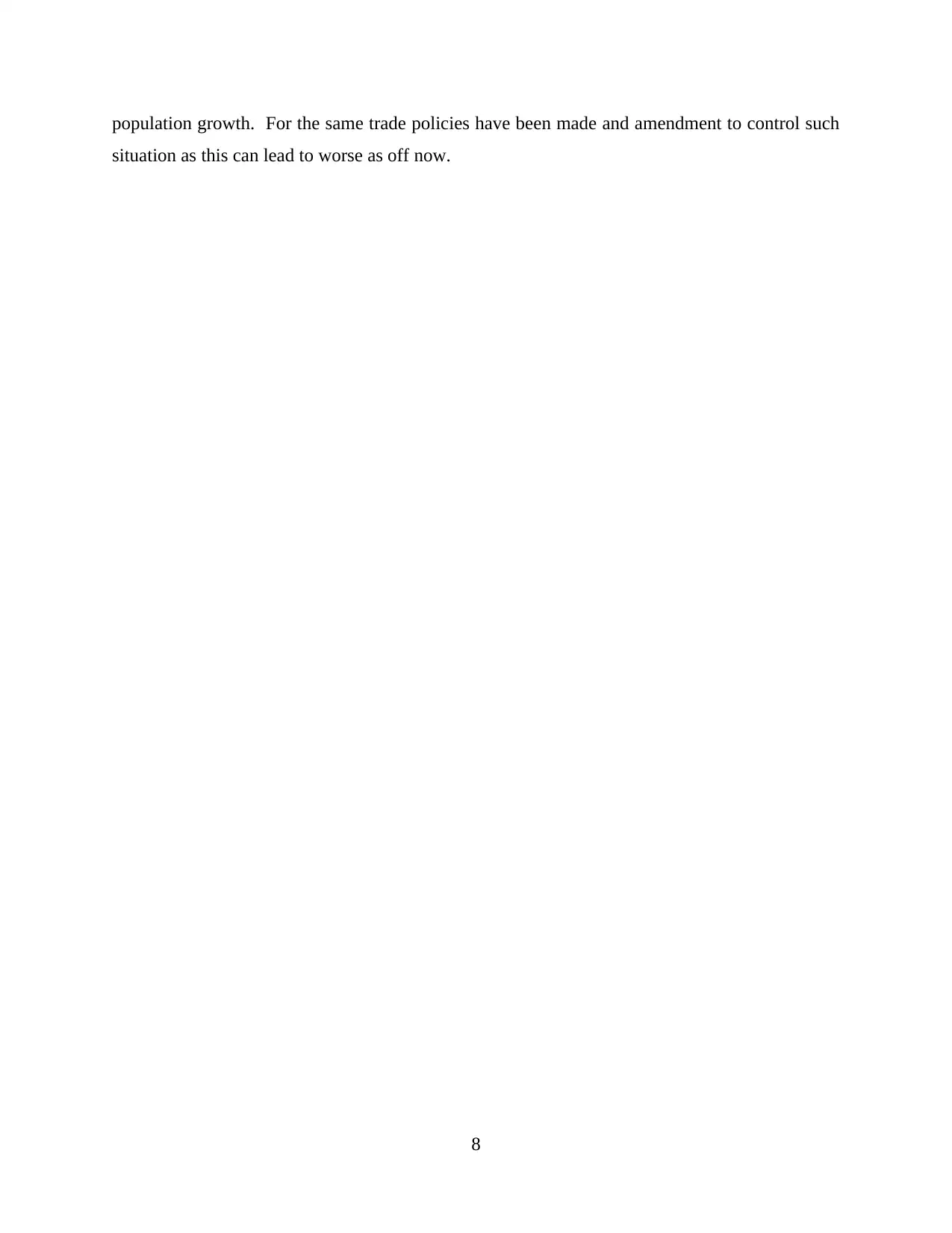
population growth. For the same trade policies have been made and amendment to control such
situation as this can lead to worse as off now.
8
situation as this can lead to worse as off now.
8

REFERENCES
Books and Journals
Beverelli, C., Neumueller, S., & Teh, R. (2015). Export diversification effects of the wto trade
facilitation agreement. World Development. 76. 293-310.
Chaudoin, S., Kucik, J., & Pelc, K. (2016). Do WTO disputes actually increase
trade?. International Studies Quarterly. 60(2). 294-306.
Davis, C. L., & Wilf, M. (2017). Joining the Club: Accession to the GATT/WTO. The Journal
of Politics.79(3). 964-978.
Flentø, D., & Ponte, S. (2017). Least-developed countries in a world of global value chains: are
WTO trade negotiations helping?. World Developmen. 94. 366-374.
Mansfield, E. D., & Reinhardt, E. (2015). International institutions and the volatility of
international trade. In THE POLITICAL ECONOMY OF INTERNATIONAL TRADE. (pp.
65-96).
Online
China: Trade balance from 2007 to 2017. 2018. [Online]. Available through
:<https://www.statista.com/statistics/263632/trade-balance-of-china/>.
The Challenges of China’s Rapid Growth. 2018. [Pdf]. Available through
:<http://arno.uvt.nl/show.cgi?fid=129484>.
Financial markets - Statistics & Facts. 2018. [Online]. Available through
:<https://www.statista.com/topics/1165/financial-markets/>.
Nickhouse, P., 2017. UK bridging market study. [Online]. Available through:
<https://www.ey.com/Publication/vwLUAssets/EY-UK-bridging-market-study-2018-and-
beyond/%24FILE/EY-UK-bridging-market-study-2018.pdf>.
Monetary policy. 2018. [Online]. Available through:
<https://www.bankofengland.co.uk/monetary-policy>.
9
Books and Journals
Beverelli, C., Neumueller, S., & Teh, R. (2015). Export diversification effects of the wto trade
facilitation agreement. World Development. 76. 293-310.
Chaudoin, S., Kucik, J., & Pelc, K. (2016). Do WTO disputes actually increase
trade?. International Studies Quarterly. 60(2). 294-306.
Davis, C. L., & Wilf, M. (2017). Joining the Club: Accession to the GATT/WTO. The Journal
of Politics.79(3). 964-978.
Flentø, D., & Ponte, S. (2017). Least-developed countries in a world of global value chains: are
WTO trade negotiations helping?. World Developmen. 94. 366-374.
Mansfield, E. D., & Reinhardt, E. (2015). International institutions and the volatility of
international trade. In THE POLITICAL ECONOMY OF INTERNATIONAL TRADE. (pp.
65-96).
Online
China: Trade balance from 2007 to 2017. 2018. [Online]. Available through
:<https://www.statista.com/statistics/263632/trade-balance-of-china/>.
The Challenges of China’s Rapid Growth. 2018. [Pdf]. Available through
:<http://arno.uvt.nl/show.cgi?fid=129484>.
Financial markets - Statistics & Facts. 2018. [Online]. Available through
:<https://www.statista.com/topics/1165/financial-markets/>.
Nickhouse, P., 2017. UK bridging market study. [Online]. Available through:
<https://www.ey.com/Publication/vwLUAssets/EY-UK-bridging-market-study-2018-and-
beyond/%24FILE/EY-UK-bridging-market-study-2018.pdf>.
Monetary policy. 2018. [Online]. Available through:
<https://www.bankofengland.co.uk/monetary-policy>.
9
⊘ This is a preview!⊘
Do you want full access?
Subscribe today to unlock all pages.

Trusted by 1+ million students worldwide
1 out of 12
Related Documents
Your All-in-One AI-Powered Toolkit for Academic Success.
+13062052269
info@desklib.com
Available 24*7 on WhatsApp / Email
![[object Object]](/_next/static/media/star-bottom.7253800d.svg)
Unlock your academic potential
Copyright © 2020–2025 A2Z Services. All Rights Reserved. Developed and managed by ZUCOL.





